Scientists develop new perovskite-type superlattices with potential application in optical quantum computing
|Perovskite is a calcium titanium oxide mineral composed of calcium titanate (CaTiO3) characterised by a particular crystal structure. Nowadays, any compound sharing the structure with calcium titanate is called perovskite and its properties may vary depending on which elements are used to build the structure. The features of materials based on lead halide perovskites are of relevant interest in several fields of technology, especially in correlation with how light interacts with perovskites. For instance, they have a remarkable efficiency in absorbing photons and therefore are a promising material for next-generation solar cells characterised by higher efficiency and lower costs. Another example of application is quantum dots, a technology applied in next-generation televisions and monitors.
Ihor Cherniukh, Dr. Maryna Bodnarchuk and Prof. Maksym Kovalenko, from ETH Zurich and EMPA- Swiss Federal Laboratories for Materials Sciences and Technologies reported in a Nature publication, together with colleagues, the co-assembly of perovskite-type superlattices from lead halide perovskite nanocubes and Fe3O4 nanospheres. In this study, cubic and spherical nanocrystals were co-assembled into a superlattice, demonstrating that these structures exhibit superfluorescence characterised by emission pulses with ultrafast radiative decay (22 picoseconds). Grazing Incidence Small-Angle X-ray Scattering (GISAXS), available at the Austrian CERIC Partner Facility at Elettra Sincrotrone Trieste, is among the analytical techniques that allowed to gather fundamental structural insights on the sample study.

This scientific work provided relevant insights about perovskite-based materials as quantum light sources. Further engineering of perovskite superlattices at the mesoscale and the microscale could have relevant optical quantum computing and quantum imaging applications.



